|
Farnsworth's Charge at Gettysburg
| General Farnsworth's Charge |
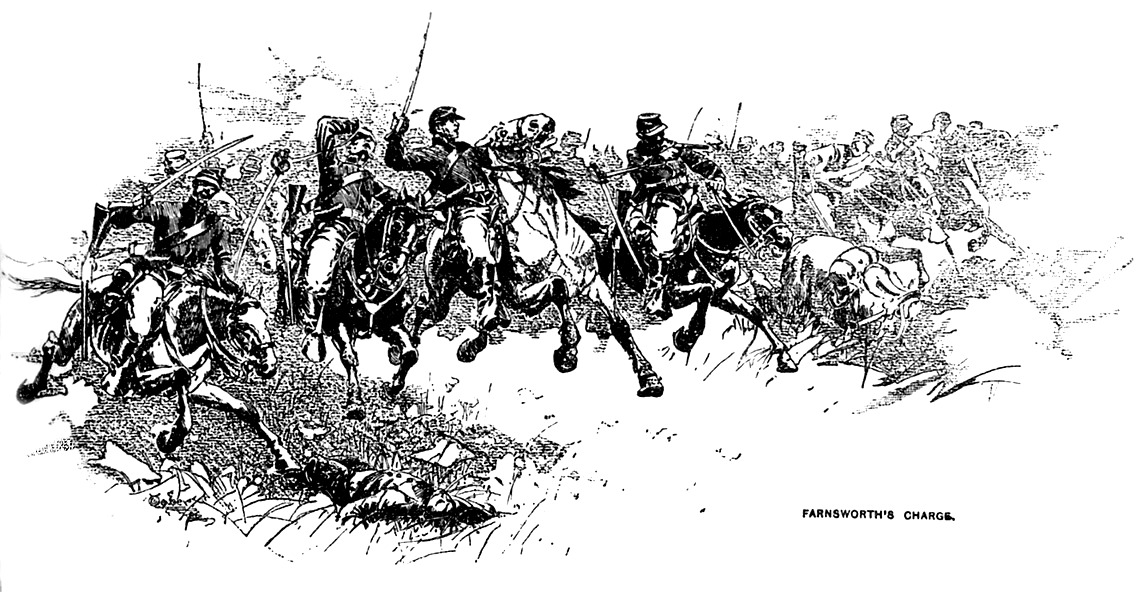
|
| (Battles & Leaders) |
"Each man felt... that he was summoned to a ride of
death." - Captain H. C. Parsons, 1st Vermont Cavalry
| General Elon J. Farnsworth |
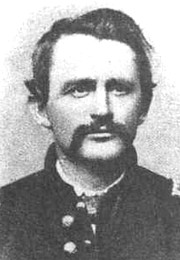
|
| (National Archives) |
A
tragic footnote to the carnage of July 3 occurred in the farm fields and woods south of Big Round Top. Elon J. Farnsworth,
a newly appointed brigadier general, led his brigade of Union troops to Gettysburg and into his first and last battle.
Farnsworth
was born in Green Oak, Livingston County, Michigan, on July
30, 1837, and his family moved to Illinois in 1854. He graduated
from the University of Michigan
in 1858. During the "Mormon Expedition" in 1858 in the Utah
Territory, he served as a civilian foragemaster on the staff of General
Albert Sidney Johnston. He also worked as a buffalo hunter and scout in the Colorado Territory.
At
the outbreak of the Civil War, Farnsworth was appointed a first lieutenant in the 8th Illinois Cavalry and he served with
distinction; the regiment was commanded by his uncle, John F. Farnsworth.
He
was promoted to captain on December 25, 1861, and was appointed Assistant Chief Quartermaster of the IV Corps. In the Battle of Chancellorsville and early stages of the Gettysburg Campaign in 1863, he served faithfully as aide-de-camp
to Brig. Gen. Alfred Pleasonton. On
June 29, 1863, just days before the Battle of Gettysburg, he was promoted to brigadier general of volunteers by Pleasonton. He was appointed
as commander of 1st Brigade, 3rd Division, Cavalry Corps, Army of the Potomac.
| South Cavalry Field at Gettysburg Battlefield Map |
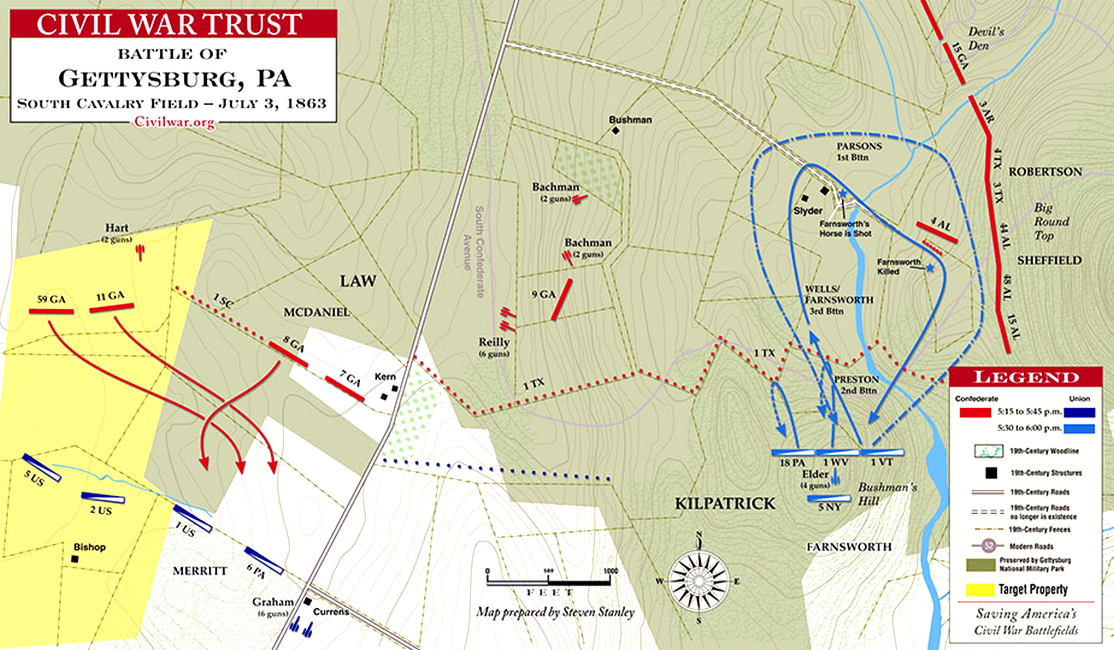
|
| South Cavalry Field at Battle of Gettysburg, July 3, 1863 |
General Farnsworth spent the next several days with his brigade on various
assignments and flanking duty until the afternoon of July 3, when he was ordered to make what became a hopeless charge into
the rear of Confederate General John Bell Hood's Division, resulting in his death. "Farnsworth's Charge" as it has come to be
known, was primarily made by the 1st Vermont Cavalry under the command of Lt. Colonel Addison W. Preston. Captain Henry C.
Parsons, commanding Company L, 1st Vermont, accompanied Farnsworth that day. Fifty years later, Parsons returned to Gettysburg
and spoke on his experiences at the same location where they took place. Following are the highlights of his speech of July
3, 1913:
"It is remarkable that the most deliberate and desperate cavalry charge made
during the Civil War passed so nearly unnoticed that the attention of the country was first drawn to it by reports of the
enemy. The charge was directly ordered by General Meade and immediately after it was made he sent a congratulatory dispatch,
and yet when the report went up that Farnsworth was killed and the regiment that he led all but annihilated, this order was
withheld from the Official Report. The friends of Farnsworth attacked Kilpatrick for having ordered a wanton waste of life
and he remained silent. If the charge had been on any other part of the field, or at an earlier hour of the day, it would
have commanded wide attention. As it was, it was witnessed only by the enemy and by the few men at the batteries.
"After the repulse of Pickett, Meade's attention was drawn to an apparent
movement of the enemy's troops towards the right. His left wing was peculiarly unprotected. Law's brigade was firmly lodged
on the side of Round Top, and the valley to which Longstreet's eye turned so eagerly was open. An order
reached Kilpatrick to hurl his cavalry on the rear of Law's brigade and create so strong a diversion that Lee's plan would
be disclosed. At the moment of receiving this order Kilpatrick's forces were widely scattered. Custer was fighting with Gregg,
the Reserve was with Merritt, the 5th New York was on the skirmish line, nothing was within striking distance but
the 1st West Virginia and the 1st Vermont. The 1st West Virginia was sent across the open
fields and against the 1st Texas Infantry and was repulsed after a second charge with great loss. The first and
third battalions of the 1st Vermont were sent under cover of all the guns that could be brought into position over
fences, through timber and up rocky sides of Round Top directly in rear of Law's brigade. They received the direct enfilading
fire of three regiments, and of a battery of artillery. They drew two regiments out of line and held them in new positions,
breaking the Confederate front and exposing it to an infantry charge if one had been immediately ordered. So bold was their
assault that the Confederates received it as the advance of a grand attack, and finding themselves exposed to infantry in
front and cavalry in the rear, were uncertain of their position.
"The whole number who rode in the charge was about three hundred. Their casualties
were sixty-five. Their prisoners were one hundred and twenty. They rode within the Confederate line nearly two miles and the
regiment, instead of being annihilated, is reported as having taken part in subsequent engagements.
| Battle of Gettysburg Map |
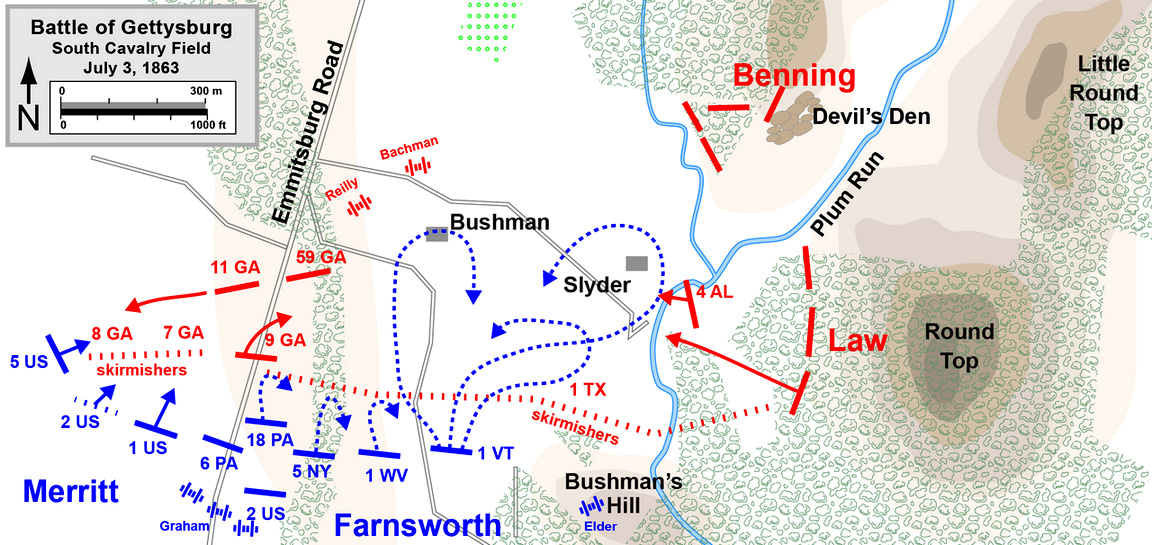
|
| South Cavalry Battlefield of Gettysburg |
| General Judson Kilpatrick |
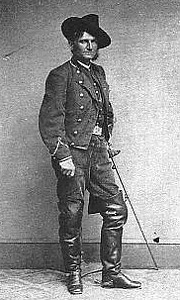
|
| (USAMHI) |
"The Cavalry under Kilpatrick went into position on the left… about noon of the third day. When the
cannonade that preceded Pickett's Charge opened (,) General Farnsworth rode out … and I think Kilpatrick joined him.
I was sent for and at that moment saw a long skirmish line moving towards us and crossing the high rail fence that surround(s)
the Bushman farm. I was ordered to take a squadron, charge this line as foragers and if I drove them back to ride to cover
of the stone house and wait for orders or support. As soon as the cavalry appeared the enemy fell back behind the fences and
we rode down, receiving their fire, with the loss of one man and two horses. I immediately ordered Lieut. Watson to take twelve
men, to ride out and throw down the fences and expected (a)signal to charge. They rode out under a fierce volley, threw down
the fences and reported to me, 'Your order is executed; (George S.) Brownell is dead.' Their skirmish line fell back in confusion,
a squadron was sent to my support but the order to charge did not come. We remained some time in this advanced position and
saw part of the magnificent movement towards Little Round Top. When recalled, we rode back under fire without loss. Kilpatrick came towards me with spirit: 'Captain, the
jolliest fight I ever saw; four men with revolvers riding down a line of infantry delivering their fire and driving them back;
you are a soldier.'
"I was at last able to say: 'You are mistaken, I was not there. I did not
even see it. Send for Lieutenant (Alexander G.) Watson and thank him.'
"There was an oppressive stillness after the day's excitement. I rode to the
front and found General Kilpatrick standing by his horse. He showed great impatience and eagerness for orders. The great opportunity,
which was to have hurled his two brigades across the open fields upon the right and rear of Pickett's broken columns had been
allowed to pass. As I turned away an orderly dashed by shouting: 'We turned the charge, nine acres of prisoners.' In a moment
an aide came down and Kilpatrick sprang into his saddle and rode towards him. The verbal order I heard delivered was: 'Hood's
division is turning our left; play all your guns; charge in their rear; create a strong diversion.'
"In a moment, Farnsworth rode up. Kilpatrick impetuously repeated the order.
Farnsworth, who was a tall man with military bearing, received the order in silence. It was repeated. Farnsworth spoke with
emotion: 'General, do you mean it? Shall I throw my handful of men over rough ground, through timber, against a brigade of
infantry?'
"Kilpatrick said: 'A handful! You have the four best regiments in the army!'
Farnsworth answered: You forget, the first Michigan is detached, the 5th New York you have sent beyond call, and
I have nothing left but the 1st Vermont and the 1st West Virginia, regiments fought half to pieces.
They are too good men to kill.' Kilpatrick turned, greatly excited and said: 'Do you refuse to obey my orders? If you are
afraid to lead the charge, I will lead it.'
| Official Battle of Gettysburg Map |
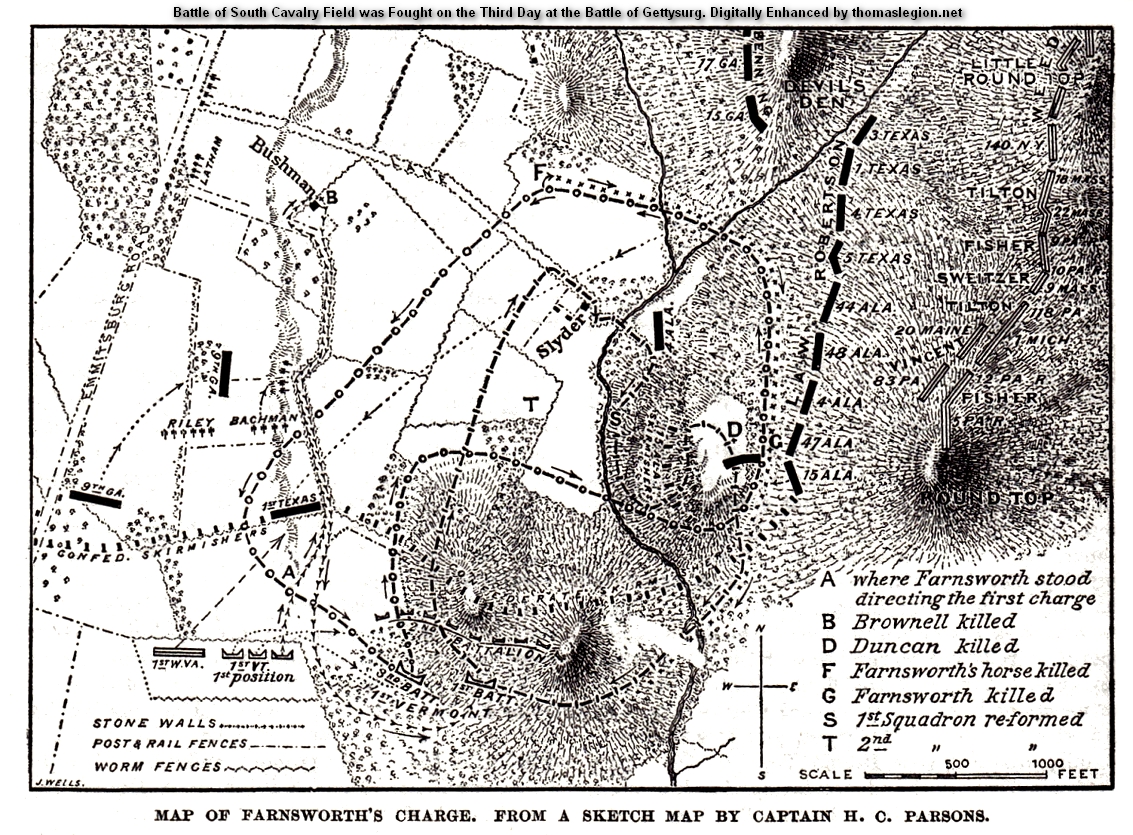
|
| Official Gettysburg Battlefield Map |
| General Farnsworth's Charge |
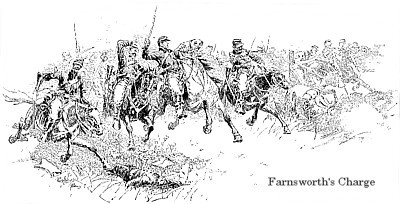
|
| Battles & Leaders |
"Farnsworth rose in his stirrups and leaned forward, with his sabre half-drawn;
he looked magnificent in his passion and cried: 'Take that back!' Kilpatrick rose defiantly, but repentingly said: 'I did
not mean it; forget it.' For a moment, nothing was said. (Then) Farnsworth spoke: 'General, if you order the charge I will
lead it, but you must take the awful responsibility.' I did not hear the low conversation that followed, but as Farnsworth
turned away, he said: 'I will obey your order.' They shook hands and parted in silence. I recall the two young generals at
that moment in the shadow of the oaks and against the sunlight, Kilpatrick with his fine gestures, his blond beard, his soft
hat turned up jauntily and his face lighted with the joy that always came into it when the charge was sounded. Farnsworth-
heavy browed, stern and pale but riding with conscious strength and consecration… two men opposite in every line of
character, but both born to desperate daring.
"The direction of our guns was changed… (and) the artillery duel began.
A shell shrieked down the line of my front company a few feet above their heads, covering them with leaves and branches. We
rode out in columns of fours with drawn sabres. After giving the order to me, General Farnsworth took his place at the head
of the 3rd Battalion.
"As the 1st Battalion rode through the line of our dismounted skirmishers
who were falling back, they cried to us to halt. As we passed out from the cover of the woods, the 1st West Virginia
were falling back in disorder on our left. A frantic horse with one leg torn off by a cannon ball rushed towards us for protection.
We rode rapidly to the left and then to the right, across a depression at the left of a stone wall. The sun was blinding and
Captain (Oliver T.) Cushman, who rode at my right, shaded his eyes and cried: 'An ambuscade!' We were immediately upon the
enemy, and the deadly (Confederate) volley was fired, but it passed over our heads. It was the most concentrated volley I
ever heard. Taken by surprise, they had shot over us. With the head of the column we cleared the fence at the right and formed
under cover of a hill. The 3rd Battalion under Major (William) Wells, a young officer who bore a charmed life and
was destined to pass through many daring encounters… moved out in splendid form to the left of the 1st Battalion,
and swept in a great circle to the right around the front of the hill and across our path, then guiding to the left across
the valley and up the side of the hill at the base of Round Top. Upon this hill was a field enclosed with heavy stone walls.
They charged along the wall and between it and the mountain directly in the rear of several Confederate regiments in position
and between them and the 4th Alabama. It was a swift… charge over rocks, through timber, under close enfilading
fire. The rush was the war of a hurricane. The direction towards Devil's Den. At the foot of the declivity the column turned left, rode close to a battery, receiving the fire of its support, and swept
across the open field and upon the rear of the Texas skirmish line. Farnsworth's horse had fallen; a trooper sprang from the
saddle, gave the General his horse and escaped on foot. Captain Cushman and a few others with Farnsworth turned back. The
1st Battalion was again in motion. The enemy's sharpshooters appeared in the rocks above us and opened fire. We
rode obliquely up the hill in the direction of Wells, then wheeling to the left between the picket line and the wall. From
this point, part of my men turned back with prisoners. The head of the column leapt the wall, into the open field. Farnsworth,
seeing the horsemen, raised his sabre and charged as if with an army. At almost the same moment his followers and what remained
of the 1st Battalion cut their way through the 15th Alabama, which was wheeling into position at a run and offered little resistance. We charged in the same direction but on opposite
sides of the wall that parallels Round Top and within two hundred paces of each other.
"Sergeant (George H.) Duncan, a black-eyed, red-cheeked boy, splendidly mounted,
standing in his stirrups, flew past me with his sabre raised and shouted: 'Captain, I'm with you!' and threw up his left hand
and fell. My horse recoiled over his dead body, my men swept past and I was a moment alone on the field. The enemy ran up
crying 'Surrender!' as if they did not want to shoot me, but as I raised my sabre a gun was planted against my breast and
fired; my horse was struck at the same moment and broke frantically through the men, over the wall and down the hill. Corporal
Waller overtook me from the left and riding close supported me on my horse. As we rode on he told me how Farnsworth and Cushman
fell together.
"I doubt if an order was given beyond the waving of a sabre after the first
(order). The officers rode at the front and the men followed and as the officers fell the men pressed on more furiously. In
that charge the private in the last file rode as proudly as the General. Farnsworth fell in the enemy's lines with his sabre
raised, dead with five wounds, and received a tribute for gallantry from the enemy that his superiors refused. There was no
encouragement of on looking armies, no cheer, no bravado. There was consecration and each man felt as he tightened his sabre
belt that he was summoned to a ride of death." (See also Civil War Cavalry and Mounted Forces at Gettysburg: Union and Confederate Weapons,
Battles, Uniforms, Roles, Tactics, and Organization.)
H. C. Parsons, July 1913
(Speech is in the Library Files of Gettysburg National Military Park; courtesy of Mr. David
Sterling)
Sources: National Archives; Library of Congress; Official Records of the Union and Confederate Armies; National
Park Service; Gettysburg National Military Park; Map courtesy Civil War Trust; "Gettysburg South Cavalry Field" by Map by
Hal Jespersen,posix.com/CW. Licensed under CC BY 3.0 via Commons.
Recommended Reading: The Cavalry at Gettysburg: A Tactical Study of Mounted Operations during the Civil War's Pivotal Campaign,
9 June-14 July 1863. Description: For cavalry
and/or Gettysburg enthusiasts, this book is a must; for other
Civil War buffs, it possesses the qualities sought by students of the conflict. It bristles with analysis, details, judgements,
personality profiles, and evaluations and combat descriptions, even down to the squadron and company levels. The mounted operations
of the campaign from organizational, strategic, and tactical viewpoints are examined thoroughly. Continued below...
The author's
graphic recountings of the Virginia fights at Brandy Station, Aldie, Middleburg, and Upperville, the Pennsylvania encounters
at Hanover, Hunterstown, Gettysburg, and Fairfield, and finally the retreat to Virginia, are the finest this reviewer has
read under a single cover. For those who enjoy the thunder of hoofbeats, the clang of sabers, and the crack of pistols and
carbines, this book has all of it. Generals and privates share the pages, as the mounted opponents parry and thrust across
hundreds of miles of territory from June 9 to July 14, 1863.
Advance to:
Recommended Reading: Lincoln's Cavalrymen: A History of the Mounted Forces of the Army of the Potomac,
1861-1865 (Hardcover). Description: Well
known in Civil War circles, author Longacre (The Cavalry at Gettysburg, etc.) has written a
major work on the Union cavalry of the North's primary field army in Virginia.
Having mined more than 300 manuscript collections as well as numerous primary sources and secondary studies, Longacre has
crafted a carefully written, well-researched tome. From the beginning of the war to Appomattox Court House, he examines the
Regular Army's prewar mounted troops, then follows the genesis of the volunteer cavalry, a process that was painfully slow,
especially given 1861 predictions that put the war's duration at three months. Continued below...
A perceptive
chapter on arms, mounts, equipment and drill provides a fresh look at the problems inherent in raising and equipping volunteers
on horseback. Included are capsule biographies and critical assessments of the cavalry's leaders, men like George Stoneman,
John Buford, Alfred Pleasonton, George A. Custer and Phil Sheridan. Throughout, the author details the skirmishes, battles
and raids conducted by Union cavalry without quite resorting to blow-by-blows. The focus is rather on the cavalry's role in
the broader context of the war in the east and its many campaigns. Within this framework, Longacre succeeds brilliantly in
showing us a crucial, much-tested force and he includes numerous photos and maps.
Recommended Reading:
Struggle for the Round Tops: Law's Alabama Brigade at the Battle
of Gettysburg.
Description: Morris M. Penny and J. Gary Laine have produced a compelling story of Law's Alabama
Brigade's attempt to wrest the Round Tops from Federal hands. In July 1863, Evander McIver Law, age 26, was one of Robert
E. Lee's most promising generals. His brigade of Alabamians shared the Army of Northern Virginia's sense of invincibility.
After a grueling 25-mile march to the battlefield, Law's men made a valiant three-hour effort to gain control of the high
ground on the Federal right. Continued
below.
Struggle for
the Round Tops describes the vicious fighting around Devil's Den, in the Devil's Kitchen, and the heartbreaking repulse from
Little Round Top. Law's Alabamians participated in the defense of the Confederate right on July 3 and delighted in unhorsing
a number of Federal troopers in Farnsworth's Charge. Two days after it
arrived, the brigade retired from the field with the realization that the Federals had matched their own fighting ability.
Law himself departed with the seeds of discord planted that would ultimately culminate in a devastating feud between himself
and Longstreet. Much has been written about the conduct of the Confederate commanders on July 2. Some historians have suggested
that Law deliberately disobeyed an order to launch his assault up the Emmitsburg
Road. The authors examine the implications of Lee's orders and offer new
insight into Hood's and Law's perspective of the situation and the leeway Hood assumed as a division commander.
Recommended Reading: General Lee's
Army: From Victory to Collapse. Review: You cannot say that University of North Carolina
professor Glatthaar (Partners in Command) did not do his homework in this massive examination of the Civil War–era lives
of the men in Robert E. Lee's Army of Northern Virginia. Glatthaar spent nearly 20 years examining and ordering primary source
material to ferret out why Lee's men fought, how they lived during the war, how they came close to winning, and why they lost.
Glatthaar marshals convincing evidence to challenge the often-expressed notion that the war in the South was a rich man's
war and a poor man's fight and that support for slavery was concentrated among the Southern upper class. Continued below...
Lee's army
included the rich, poor and middle-class, according to the author, who contends that there was broad support for the war in
all economic strata of Confederate society. He also challenges the myth that because Union forces outnumbered and materially
outmatched the Confederates, the rebel cause was lost, and articulates Lee and his army's acumen and achievements in the face
of this overwhelming opposition. This well-written work provides much food for thought for all Civil War buffs.
Recommended Reading: Commanding the Army of the Potomac
(Modern War Studies) (Hardcover). Description: During
the Civil War, thirty-six officers in the Army of the Potomac were assigned corps commands
of up to 30,000 men. Collectively charged with leading the Union's most significant field army, these leaders proved their
courage in countless battlefields from Gettysburg to Antietam to Cold
Harbor. Unfortunately, courage alone was not enough. Their often dismal performances played a major role in producing
this army's tragic record, one that included more defeats than victories despite its numerical and materiel superiority. Stephen
Taaffe takes a close look at this command cadre, examining who was appointed to these positions, why they were appointed,
and why so many of them ultimately failed to fulfill their responsibilities. Continued below...
He demonstrates
that ambitious officers such as Gouverneur Warren, John Reynolds, and Winfield Scott Hancock employed all the weapons at their
disposal, from personal connections to exaggerated accounts of prowess in combat, to claw their way into these important posts.
Once appointed, however, Taaffe reveals that many of these officers failed to navigate the tricky and ever-changing political
currents that swirled around the Army of the Potomac. As a result, only three of them managed to retain their commands for more than
a year, and their machinations caused considerable turmoil in the army's high command structure. Taaffe also shows that their
ability or inability to get along with generals such as George McClellan, Ambrose Burnside, Joseph Hooker, George Meade, and
Ulysses Grant played a big role in their professional destinies. In analyzing the Army of the Potomac's
corps commanders as a group, Taaffe provides a new way of detailing this army's chronic difficulties-one that, until now,
has been largely neglected in the literature of the Civil War.
Recommended Reading: Lee's Cavalrymen: A History of the Mounted Forces of the Army of Northern Virginia,
1861-1865 (Hardcover). Description: A companion to his previous work, Lincoln's
Cavalrymen, this volume focuses on the cavalry of the Army of Northern Virginia its leadership, the military life of its officers
and men as revealed in their diaries and letters, the development of its tactics as the war evolved, and the influence of
government policies on its operational abilities. All the major players and battles are involved, including Joseph E. Johnston,
P. G. T Beauregard, and J. E. B. Stuart. As evidenced in his previous books, Longacre's painstakingly thorough research will
make this volume as indispensable a reference as its predecessor.
|

